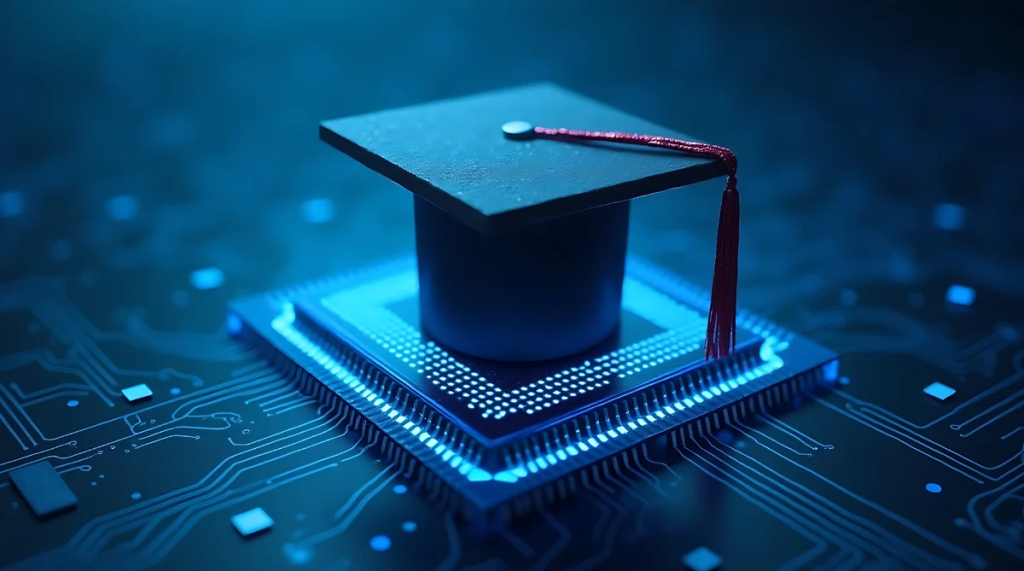AI Is Transforming the Classroom: What Student-Athletes Need to Know About the Changing Educational Landscape

Artificial Intelligence (AI) is making waves in education, and it’s not just about speeding up research or making things more efficient. It’s fundamentally changing how students—especially student-athletes—interact with learning, creating both challenges and opportunities for those juggling academics and athletics.
AI has already found its way into classrooms, whether instructors were ready for it or not. With AI tools offering 24/7 access to explanations, summaries, and even completing assignments, the role of homework is rapidly evolving. Faculty now have a choice: How can they redesign their teaching when students can access AI-driven content faster and more efficiently than ever before?
For student-athletes, this shift has huge implications. With tight schedules and the need to manage both school and sports, AI provides a tool that can make learning more efficient. However, it also means that traditional homework assignments—which may already be tough for athletes to balance—are no longer the sole method of reinforcing content. Instead, the focus is shifting towards skill-building, application, and mastery of the content in a way that AI alone cannot replace.
The Traditional Homework Model: Not Working for Student-Athletes
For years, the homework model in education has been based on reinforcing classroom lessons with assignments that often lack direction or purpose. Many times, assignments are vague: “Read chapters 7, 9, and 10,” but what exactly are students supposed to learn or demonstrate through this reading? For student-athletes, these vague instructions can be even more frustrating as they try to balance intense training schedules and competition.
While many faculty members are well-meaning, the traditional model often asks students to absorb material passively—something that doesn’t support the active, hands-on learning that athletes are accustomed to in their sports. What’s more, student-athletes have often struggled to receive the guidance they need when working through homework on their own, especially when they are under pressure from both schoolwork and athletics.
AI’s Role in Shaping the Future of Learning for Student-Athletes
AI is changing the game. It no longer makes sense to just rely on textbooks or lectures when AI can provide instant feedback, summaries, and detailed explanations. For student-athletes, this could be a game-changer. Instead of waiting for the next class or seeking help from a professor or tutor, they can turn to AI whenever they need assistance. Whether it’s summarizing a lecture, helping understand complex concepts, or even generating a sample essay, AI can be a supportive learning tool—available 24/7.
The rise of AI means the way we think about homework must change. No longer just passive review, homework now needs to become a space where students apply, evaluate, and create, aligning directly with higher-order skills like those in Bloom’s Taxonomy. For student-athletes, this change makes sense: just like in sports, where practice involves active engagement and skill development, academic work now needs to be about actively engaging with the content.
From Passive Learning to Skill Building: How Student-Athletes Can Benefit
AI tools can help student-athletes overcome the challenge of balancing academics with sports. Rather than spending hours passively reading or memorizing material, student-athletes can use AI to actively work on assignments, analyze content, and develop problem-solving skills. Faculty are now expected to design tasks that allow students to apply what they’ve learned in real-world contexts.
For example, instead of merely reading chapters, students could be asked to compare different strategies for handling stress in sports and academics, evaluating which methods would be most effective based on current research and personal experience. This type of assignment pushes athletes to engage critically with the content, showing not just their recall abilities but their ability to analyze, synthesize, and apply knowledge.
The New Role for Faculty: A Guide, Not a Lecturer
As AI becomes a larger part of education, the role of faculty is evolving as well. Instead of just delivering content, professors are now becoming guides who help students navigate tasks that require deeper thought and application. For student-athletes, this could mean more classroom time devoted to discussion, hands-on learning, and collaboration rather than passive lectures.
Faculty will still play an essential role in the learning process, but their role will be more about helping students refine their understanding and apply it in practical, real-world situations. This shift allows student-athletes to get the most out of their limited time in the classroom by focusing on skill-building, critical thinking, and applying knowledge in dynamic ways.
What Does This Mean for Student-Athletes?
As AI tools continue to grow and develop, student-athletes must adjust to this new reality by embracing a more active, engaged, and skill-focused approach to learning. While the pressure of balancing sports and academics remains, AI can become a powerful ally in managing both. The key is for student-athletes to take control of their learning and use AI as a tool to enhance their education while still actively engaging with the material.
In conclusion, the future of higher education, especially for student-athletes, is moving away from passive learning and toward skill development, with AI acting as a valuable tool to support this shift. Faculty and students alike must embrace this transformation by rethinking how learning happens, moving beyond content delivery to ensure that every student can apply, analyze, and create based on what they’ve learned. The classroom is no longer a place where students merely absorb information; it’s where they demonstrate their skills and readiness for the real world.

